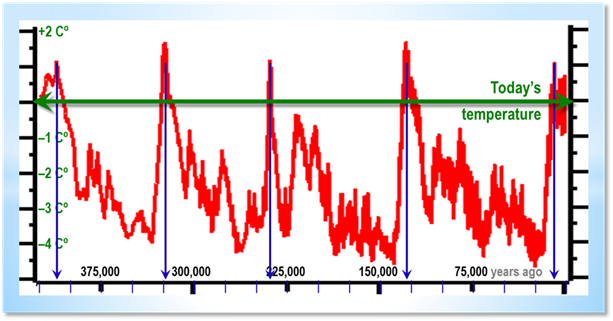OxNotes > GCSE/IGCSE Revision > GCSE Geography > Changing Climate: Past climate change and its impacts
Climate has changed in the past through natural causes, on timescales ranging from hundreds to millions of years.
Climate has changed in the past through natural causes, on timescales ranging from hundreds to millions of years.
Past climate change on different timescales
This graph of average long term temperature change shows patterns of warm, cool and cold periods over the past 450,000 years. When the temperature is cooler, lower than 0° C, more of the earth is covered in ice. This is called an Ice Age or glacial. We are currently in a warmer period, known as an interglacial.
The quarternary period is a geological time period of the most recent 2.6 million years (from the present day).
- The ‘Ice Ages’ in the Quaternary Period.
- UK climate since Roman times.
Natural causes of climate change
- Asteroid collisions - Large asteroid collisions release dust that can block out the sun and thus lower temperatures. Asteroids can cause large fires when impacting with the ground, the fires release huge amounts of CO2 (a greenhouse gas) that cause a warming effect.
- Orbital changes - Earth’s orbit changes slightly every 100,000 years.
- Volcanic activity - Volcanic eruptions pump ash dust into the atmosphere, reducing the amount of sunlight and thus cooling the Earth’s atmosphere.
- Variations in solar output - Amount of energy from the Sun changes over an 11-year cycle
How natural climate change in the past has affected people and the environment
The impact of a short-term historical event on people and the environment
The ‘Little Ice Age’:
Impact of major climatic changes in geological time
Arguments that climate killed megafauna:
The ‘Little Ice Age’:
- Colder period in northern Europe starting in 15th century and ending in the 19th.
- Crops did not grow well, reducing productivity and meaning less food output.
- The winters were very cold and summers short.
- Fewer sunspots.
- Volcanic ash in atmosphere reducing sunlight.
- It was unlikely to be caused by humans because industry wasn’t causing enough pollution at the time.
- Diaries, newspapers and paintings.
- Tree rings are thinner during cold years.
Impact of major climatic changes in geological time
- The mass extinction of megafauna at the end of the Quaternary Period.
Arguments that climate killed megafauna:
- They became extinct 5,000 years AFTER humans colonised North America and Europe.
- Megafauna couldn’t adapt from the glacial conditions that were replaced by a warmer climate. (They had small ears to reduce heat loss and lots of hair for cold weather).
- Australia changed from very cold to warm. This caused lakes and rivers to dry out which killed animals and plants, resulting in death from starvation.
- Humans hunted megafauna
- Mammoths were large targets and slow movers.
- Spear tips were found at sites of mammoths.
- Other animals did not prey on mammoths because they were so big.

